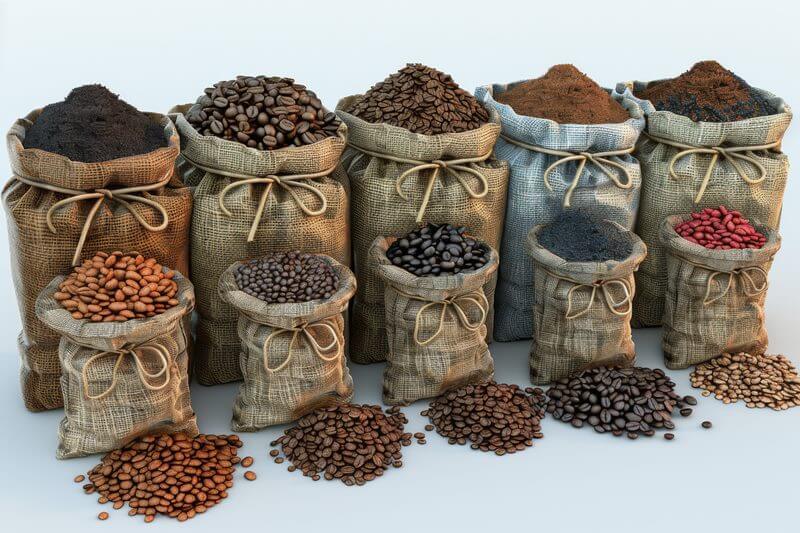Arabica vs Robusta: which one to choose?
Arabica makes up about 70% of global coffee production, while Robusta accounts for 30%. Despite its higher price, Arabica remains the top choice among consumers due to its refined taste. Growing Arabica is a labor-intensive process—it thrives in mountainous regions and requires careful cultivation, transportation, and processing. In poor harvest years, its price can rise due to crop diseases.
Taste: Smooth, refined, with floral and fruity notes.
Caffeine Content: Lower caffeine compared to Robusta.
Usage: Used in premium coffee varieties and high-quality blends for filter coffee and espresso.
Production: Makes up about 75% of global coffee production.
Growing Conditions: Requires high altitude, cooler climates and careful cultivation.
Interesting fact: Arabica emerged from the crossbreeding of Robusta and Eugenioides.
Eugenioides is a very rare type of coffee that grows on small shrubs. Its beans are tiny, and the yield is low, making large-scale cultivation impossible. This coffee has a very low caffeine content—only 0.2%. That’s why Arabica contains less caffeine than Robusta.
Robusta, on the other hand, is much more resilient. It withstands heat, heavy rains, and diseases. Its trees are 3–4 times taller than Arabica (up to 13 meters) and produce a higher yield, which lowers production costs. Robusta can grow on both plains and mountains, requires minimal care, and is highly resistant to extreme weather conditions.
A blend of Arabica and Robusta is one of the most popular high-quality coffee options on the global market.
Taste: Strong, bold, with noticeable bitterness and lower acidity.
Caffeine Content: Nearly twice as much caffeine as Arabica.
Usage: Commonly found in affordable coffee blends and espresso for added intensity and body.
Production: More resilient, with higher yields, making up around 30% of global production.
Growing Conditions: Thrives in hot, humid climates, grows on both plains and mountains and resists diseases.
Organic coffee
The caffeine beans, like all agricultural products, must be grown by rigorous environmental standards and fair labor practices, ensuring sustainability and ethical treatment of farmers throughout the entire production process. Therefore, organic types of coffee are cultivated using sustainable pesticide-free methods, preserving the biodiversity of resources.
Such certificates as Fair Trade, Organic, Rainforest Alliance, or UTZ confirm organic origin.
Rare coffee varieties
Only 100% of Arabica can receive a specialty classification. There must be zero primary defects (such as moldy or blackened beans) in a 350-gram sample of green coffee beans. To ensure defect-free beans, the product undergoes a multi-stage processing before roasting. After roasting, the coffee is further refined using an optical color sorter before being ground or packaged in airtight containers.

Everyday coffee tips
Roast matters
Referring to the most common classification, which is based on the color of the beans:
- Light roast: Ideal for drip brewing in an Aeropress, more complex, offering a variety of aromas and taste shades of coffee with pronounced acidity.
- Medium roast: Universal, because it can be brewed in a turkish coffee pot, in a cup, drips, and coffee machine. It best reveals the taste and aromatic properties.
- Dark roast: Provides richness, viscosity, and a slight bitterness (often called Italian precisely because of this bitter taste) with almost no acidity, and is delicious with milk.
The general rule is that the lighter the roast, the higher the acidity. Lightly roasted beans are drier, whereas the caffeine decreases as the roast gets darker.
Freshness check
The freshness is the most important. Immediately after roasting, the beans smell unpleasant due to the release of Сarbon Dioxide, so they are packed later, so it should rest for a few days to reach the peak of taste on the 4-7th day. So, it’s better to choose coffee from fresh lines, no more than 30 days after roasting. When the beans for brew are stored in a sealed package with a degassing valve, its flavor characteristics are maintained for one to two months.
How processing changes the flavor
The way coffee beans are processed after harvesting plays a crucial role in shaping their final flavor. Different methods highlight various taste notes, from fruity and sweet to bright and acidic.
Here are some of the most common processing methods:
- Natural: with minimal intervention of beans, getting coffee drink fruitiness and sweet.
- Washed: coffee cherries are washed with water to remove the outer skin and pulp from the beans, with acidity.
- Honey: some fruit pulp remains on the beans during drying, becoming sticky and syrupy, similar to honey.
Each processing technique creates a one-of-a-kind flavor profile, letting you craft your perfect cup based on your preferences.
Harmful or healthy? What science says
However, the secret is in the quantity. Meanwhile, excessive intake causes addiction, mineral deficiency, and sleep issues.
Feel free to experiment and look for the best one for you!
FAQ
What is the strongest coffee bean?
Uganda Robusta, which contains 4% caffeine. It’s usually added to blends rather than used alone due to its intense bitterness.
What coffee beans are best to buy?
Freshly roasted ones. They reach peak flavor between the 3rd and 21st day after roasting.
Which country grows the world's best coffee?
The best coffee isn’t tied to a specific country—any region near the equator has ideal conditions for growing Arabica. Brazil is the top producer, but the flavor potential of a specific variety matters more than its origin.

Author

Anna Smirnova
Content writer on https://rythmoftheworld.com From my practicing in science, I brought the skills of discovering, analyzing, and explanation. I adore art, photography, traveling, hiking, and winter.



